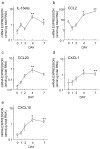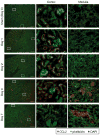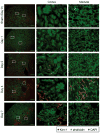Urinary chemokine (C-C motif) ligand 2 (monocyte chemotactic protein-1) as a tubular injury marker for early detection of cisplatin-induced nephrotoxicity
- PMID: 23291264
- PMCID: PMC4077184
- DOI: 10.1016/j.bcp.2012.12.019
Urinary chemokine (C-C motif) ligand 2 (monocyte chemotactic protein-1) as a tubular injury marker for early detection of cisplatin-induced nephrotoxicity
Abstract
Because of the difficulty in detecting segment-specific response in the kidney, we investigated the molecular events underlying acute kidney injury in the proximal tubules of rats with cisplatin (cis-diamminedichloroplatinum II)-induced nephrotoxicity. Microarray analysis revealed that mRNA levels of several cytokines and chemokines, such as interleukin-1beta, chemokine (C-C motif) ligand (CCL) 2, CCL20, chemokine (C-X-C motif) ligand (CXCL) 1, and CXCL10 were significantly increased after cisplatin treatment in both isolated proximal tubules and whole kidney. Interestingly, tubular CCL2 mRNA levels increased soon after cisplatin administration, whereas CCL2 mRNA levels in whole kidney first decreased and then increased. Levels of both CCL2 and kidney injury molecule-1 (KIM-1) in the whole kidney increased after cisplatin administration. Immunofluorescence analysis revealed CCL2 changes in the proximal tubular cells initially and then in the medullary interstitium. Urinary CCL2 excretion significantly increased approximately 3-fold compared with controls the day after cisplatin administration (5mg/kg), when no changes were observed plasma creatinine and blood urea nitrogen levels. Urinary levels of KIM-1 also increased 3-fold after cisplatin administration. In addition, urinary CCL2 rather than KIM-1 increased in chronic renal failure rats after administration of low-dose cisplatin (2mg/kg), suggesting that urinary CCL2 was selective for cisplatin-induced nephrotoxicity in renal impairment. These results indicated that the increase in cytokine and chemokine expression in renal epithelial cells might be responsible for kidney deterioration in cisplatin-induced nephrotoxicity, and that urinary CCL2 is associated with tubular injury and serves as a sensitive and noninvasive marker for the early detection of cisplatin-induced tubular injury.
Copyright © 2012 Elsevier Inc. All rights reserved.
Figures









Similar articles
-
Tissue Kim-1 and urinary clusterin as early indicators of cisplatin-induced acute kidney injury in rats.Toxicol Pathol. 2012 Oct;40(7):1049-62. doi: 10.1177/0192623312444765. Epub 2012 May 11. Toxicol Pathol. 2012. PMID: 22581811
-
Kidney injury molecule-1: a tissue and urinary biomarker for nephrotoxicant-induced renal injury.Am J Physiol Renal Physiol. 2004 Mar;286(3):F552-63. doi: 10.1152/ajprenal.00285.2002. Epub 2003 Nov 4. Am J Physiol Renal Physiol. 2004. PMID: 14600030
-
Urinary kidney injury molecule-1 and monocyte chemotactic protein-1 are noninvasive biomarkers of cisplatin-induced nephrotoxicity in lung cancer patients.Cancer Chemother Pharmacol. 2015 Nov;76(5):989-96. doi: 10.1007/s00280-015-2880-y. Epub 2015 Sep 25. Cancer Chemother Pharmacol. 2015. PMID: 26407820 Free PMC article. Clinical Trial.
-
The Predictive Role of the Biomarker Kidney Molecule-1 (KIM-1) in Acute Kidney Injury (AKI) Cisplatin-Induced Nephrotoxicity.Int J Mol Sci. 2019 Oct 22;20(20):5238. doi: 10.3390/ijms20205238. Int J Mol Sci. 2019. PMID: 31652595 Free PMC article. Review.
-
Mechanisms of Cisplatin nephrotoxicity.Toxins (Basel). 2010 Nov;2(11):2490-518. doi: 10.3390/toxins2112490. Epub 2010 Oct 26. Toxins (Basel). 2010. PMID: 22069563 Free PMC article. Review.
Cited by
-
Novel MAPK-dependent and -independent tubulogenes identified via microarray analysis of 3D-cultured Madin-Darby canine kidney cells.Am J Physiol Renal Physiol. 2014 May 1;306(9):F1047-58. doi: 10.1152/ajprenal.00589.2013. Epub 2014 Feb 26. Am J Physiol Renal Physiol. 2014. PMID: 24573390 Free PMC article.
-
Urinary Human Epididymis Secretory Protein 4 as a Useful Biomarker for Subclinical Acute Rejection Three Months after Kidney Transplantation.Int J Mol Sci. 2019 Sep 22;20(19):4699. doi: 10.3390/ijms20194699. Int J Mol Sci. 2019. PMID: 31546745 Free PMC article.
-
Urinary neutrophil gelatinase-associated lipocalin: a useful biomarker for tacrolimus-induced acute kidney injury in liver transplant patients.PLoS One. 2014 Oct 20;9(10):e110527. doi: 10.1371/journal.pone.0110527. eCollection 2014. PLoS One. 2014. PMID: 25329716 Free PMC article. Clinical Trial.
-
Recent Advances in Models, Mechanisms, Biomarkers, and Interventions in Cisplatin-Induced Acute Kidney Injury.Int J Mol Sci. 2019 Jun 20;20(12):3011. doi: 10.3390/ijms20123011. Int J Mol Sci. 2019. PMID: 31226747 Free PMC article. Review.
-
Six2creFrs2α knockout mice are a novel model of renal cystogenesis.Sci Rep. 2016 Nov 17;6:36736. doi: 10.1038/srep36736. Sci Rep. 2016. PMID: 27853247 Free PMC article.
References
-
- Perazella MA. Renal vulnerability to drug toxicity. Clin J Am Soc Nephrol. 2009;4:1275–83. - PubMed
-
- Mehta RL, Pascual MT, Soroko S, Savage BR, Himmelfarb J, Ikizler TA, et al. Spectrum of acute renal failure in the intensive care unit: the PICARD experience. Kidney Int. 2004;66:1613–21. - PubMed
-
- Inui K, Masuda S, Saito H. Cellular and molecular aspects of drug transport in the kidney. Kidney Int. 2000;58:944–58. - PubMed
-
- Yonezawa A, Masuda S, Nishihara K, Yano I, Katsura T, Inui K. Association between tubular toxicity of cisplatin and expression of organic cation transporter rOCT2 (Slc22a2) in the rat. Biochem Pharmacol. 2005;70:1823–31. - PubMed
Publication types
MeSH terms
Substances
Grants and funding
LinkOut - more resources
Full Text Sources
Other Literature Sources
Medical
Research Materials

